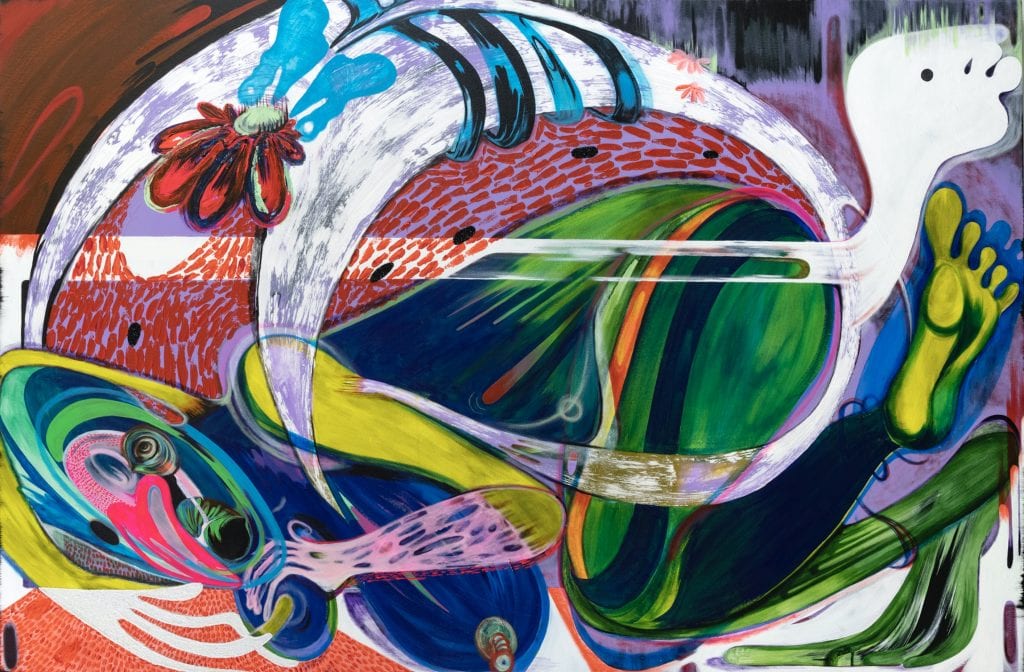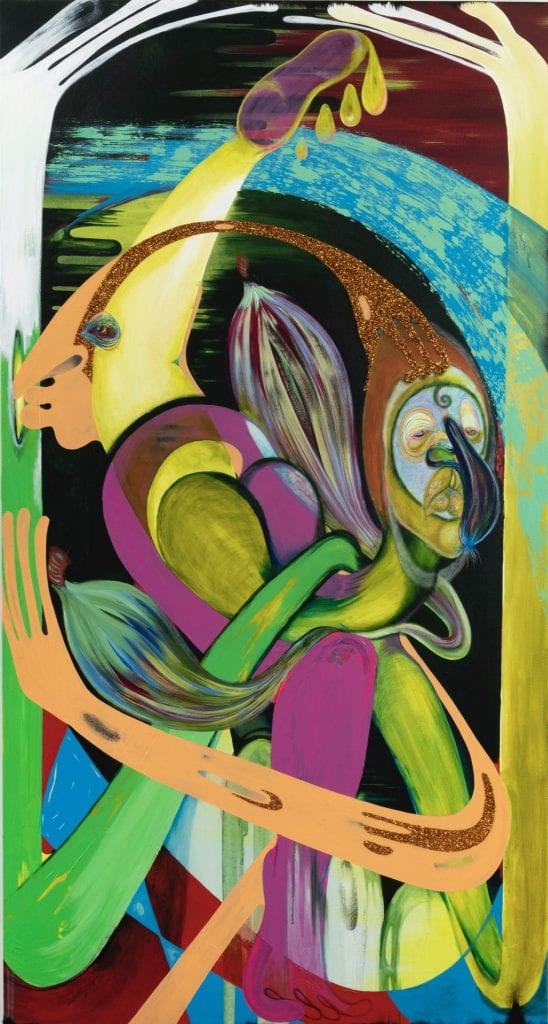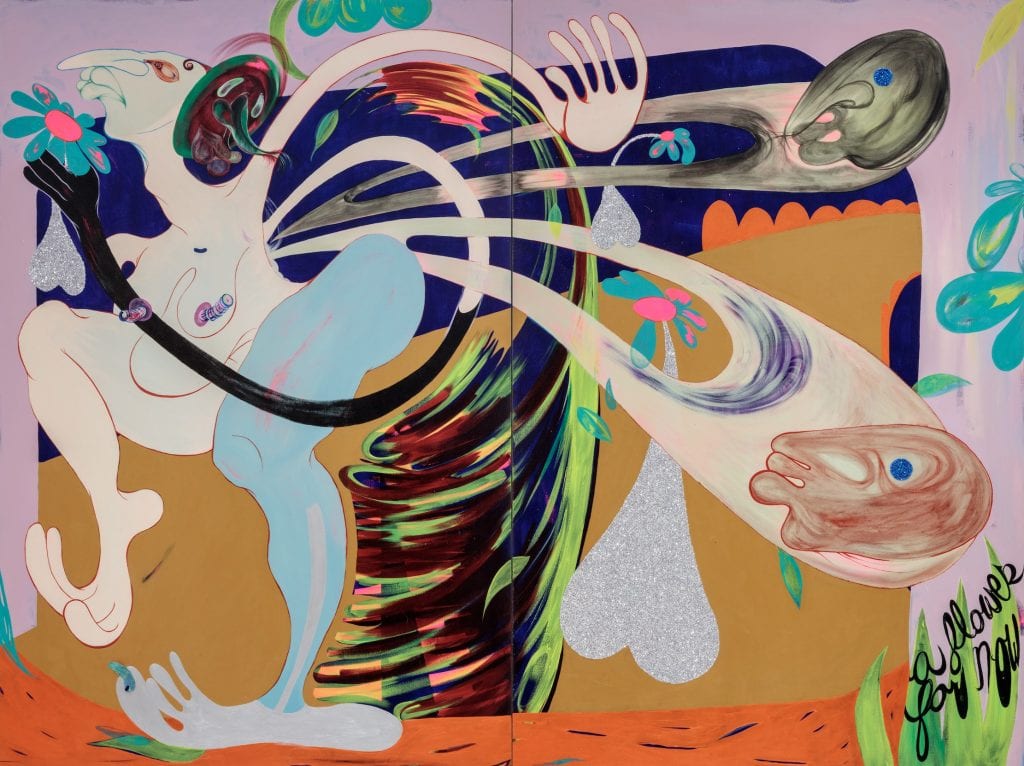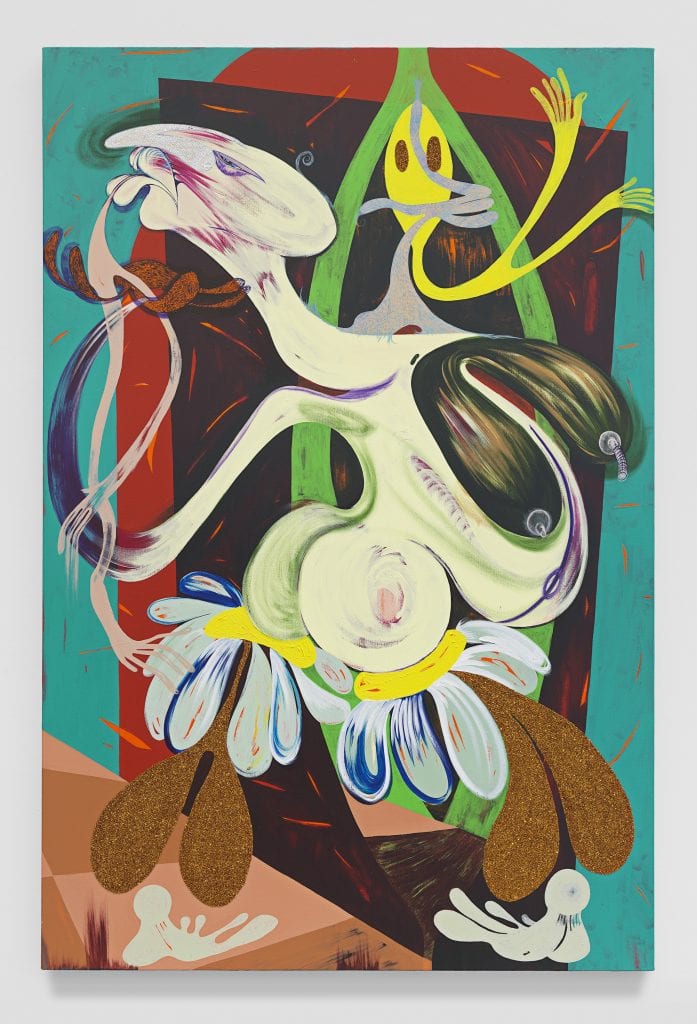Theresa Chromati’s paintings are equipped with a bold force of femininity and womanhood. Her work is bursting with expression, full of intimate symbols that tell the story of Chromati’s own life. Through her paintings, Chromati pays homage to her heavily-female upbringing in Baltimore and the artistic home that raised her. Chromati lives and works in Brooklyn, NY.

What was your experience with art like growing up?
Thank goodness for my family being my first creative community. I was born into a fun house and raised by my mom and grandparents who were all artists in their own right. I’d wake up in my bedroom, on the fourth floor of my families Baltimore row home, to music traveling up the stairwell from my grandfather and his friends jamming in our basement. Many days I would walk down the steps and visit my grandmother in her room filled with handmade trinkets and jewels that she created from newspaper clippings and plastic cutouts. Sometimes she would let me drive around town with her in her hand painted Toyota. This same Toyota would be my transportation to my very first Maryland Institute of Art (MICA) studio art class at the age of 5 (that my mom found in the newspaper). That is where I met my first art teacher Mrs. Rastegar.
Perhaps this was fate, but Mrs. Rastegar became my art teacher at my elementary/ middle school. During school art classes I had lots of encouragement. Mrs. Rastegar believed in my talent and recommended me for weekend art classes at MICA throughout my years in elementary school. Most Saturdays were dedicated to waking up early and spending the day working on multimedia pieces and having group critiques…then eventually my first group show in 4th grade.
What artists did you look up to when you were young?
I looked up to artists that were around me – my art teachers, but mainly my mother. She was enrolled in college taking studio art classes and majoring in fashion design. I would see her pulling all-nighters. I’d wake up in the morning to find a finished portrait or item of clothing and remember being amazed. In 4th grade, I witnessed my mom present a capsule collection in a fashion show for her final. She dressed my aunties and my animation teachers (that she met from my after-school animation class) in her designs. I remember heading to the fashion show after school and taking photos with my teachers wearing my mom’s collection, feeling so proud and cool. All the other kids were probably asleep, and I was doing badass things with my mom.

If you could change one thing about the current state of the art world, what would it be?
I’d like to see more shows that are actually curated from more affluent galleries. I am interested in seeing more shows where the curators are thinking about how the viewer moves through the space while viewing the works. How the interior can better support the work and the theme of the work. This can look like many things, I’d like for that to be challenged more, I’d like for larger galleries to take more conceptual challenges. Not to say that I don’t see this at all, but I would love for it to be more present.
There is some reoccurring symbolism in your work – can you talk to us about the meaning behind these motifs?
All of the “motifs” are moments and their meanings are constantly evolving over time. The mask has been a prominent motif in my work, earlier on it took a literal form. Women were depicted wearing a mask galivanting through life in an alternate dimension only accessible through archways. The mask represented performance as a tool for survival and protection for women as they maneuver through spaces. Something that could be worn to protect the purest parts of themselves.
Currently, the mask rarely takes a literal form in my work, it’s not something that the women would be attaching to their face, rather I am currently interested in revealing and embracing the duality of woman in the form of two or more faces interacting. No longer hiding aspects of herself but bringing everything to the table at once. All forms of herself are visible on her journey as joyous, loving, hectic, and unsettling as that may appear.
I’ve used motifs like pussy lips were used as a visual to embrace confidence and power. More recently I’ve introduced scrotem flowers to play with the idea of a bulging power that’s not particularly centered as something being obtained by only men or women. The figure is captured on her journey interacting with power in various different ways, sometimes clenching the scrotem flower in her hands, other times it double as legs that become a foundation which supports her body through her journey. This depiction of power is free to interact in many ways as are most of the motifs that have appeared and will appear in the work.
Not all of my motifs are constant in each work, except the Keloid chest scar. I see the women in my work as fragments of myself. Naturally, there is bodily overlap and the keloid chest scar is one example. The scar is a subtle, representation of living in your truth and finding beauty and care in that. The chest keloid is something that has appeared on my skin as well as my mother and grandmothers and introducing it into the work has been my way of finding love in something that wasn’t always easy to love.

You often include bodies in your work but present them in an ambiguous way – do these bodies represent anyone in particular?
The figures in the works are more recently all various parts of one woman. The woman depicted in the works is inspired by me but holds its own independence.
What art movements most inspire your practice?
There’s so much work from many movements that could catch my eye and raise conversation, but the Expressionist movement and Surrealist movement might have affected me the most in my current practice.
What themes are you exploring in your work?
Women are multi-dimensional. You can constantly be moving forward in life, but that can look pretty and ugly at the same time, secure and insecure all at once… all should be valued and accepted. We value love and light, but under value feelings that are somber and accompanied by darkness…ALL are important and I’m learning to explore all as beautiful lessons.

Your works explode with color and untraditional material such as glitter. Why do you include these elements?
Black women are the purest form of true expression and to me that’s lots and lots of color. I enjoy the process of layering and building forms from glitter because its beauty speaks to you at every angle. Its bold shine and weighty presence always feels out of place as well as dominant and a perfect representation of feelings I want to accompany the women in my works.
What’s next for you? What are you excited for this year?
I’m always excited to work on projects where I get a chance to work on blending media. Thankfully I am currently working on a project where I get to do this. I am also working on my first NY solo show this spring at Kravets Wehby Gallery and excited to release work building up towards the show.